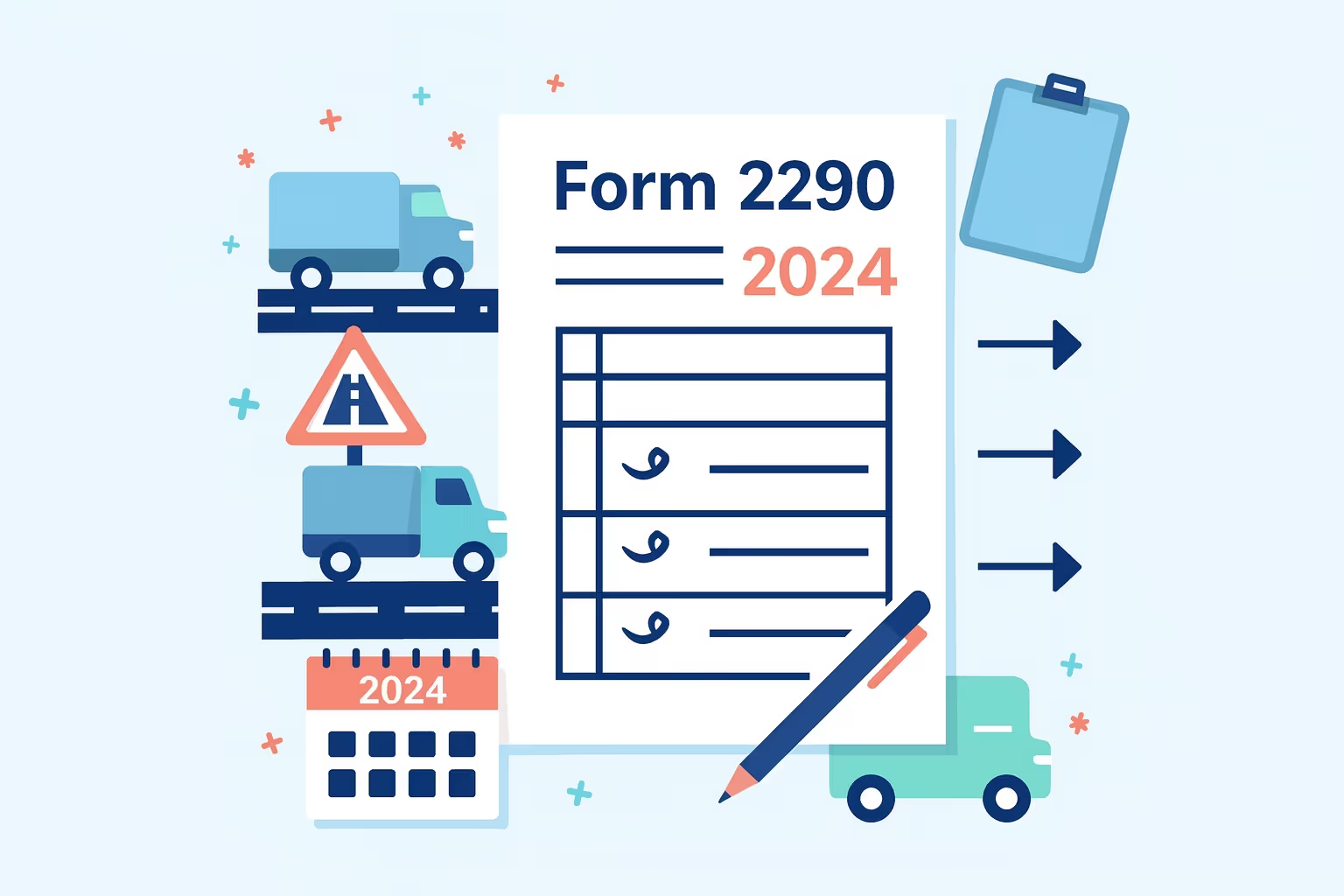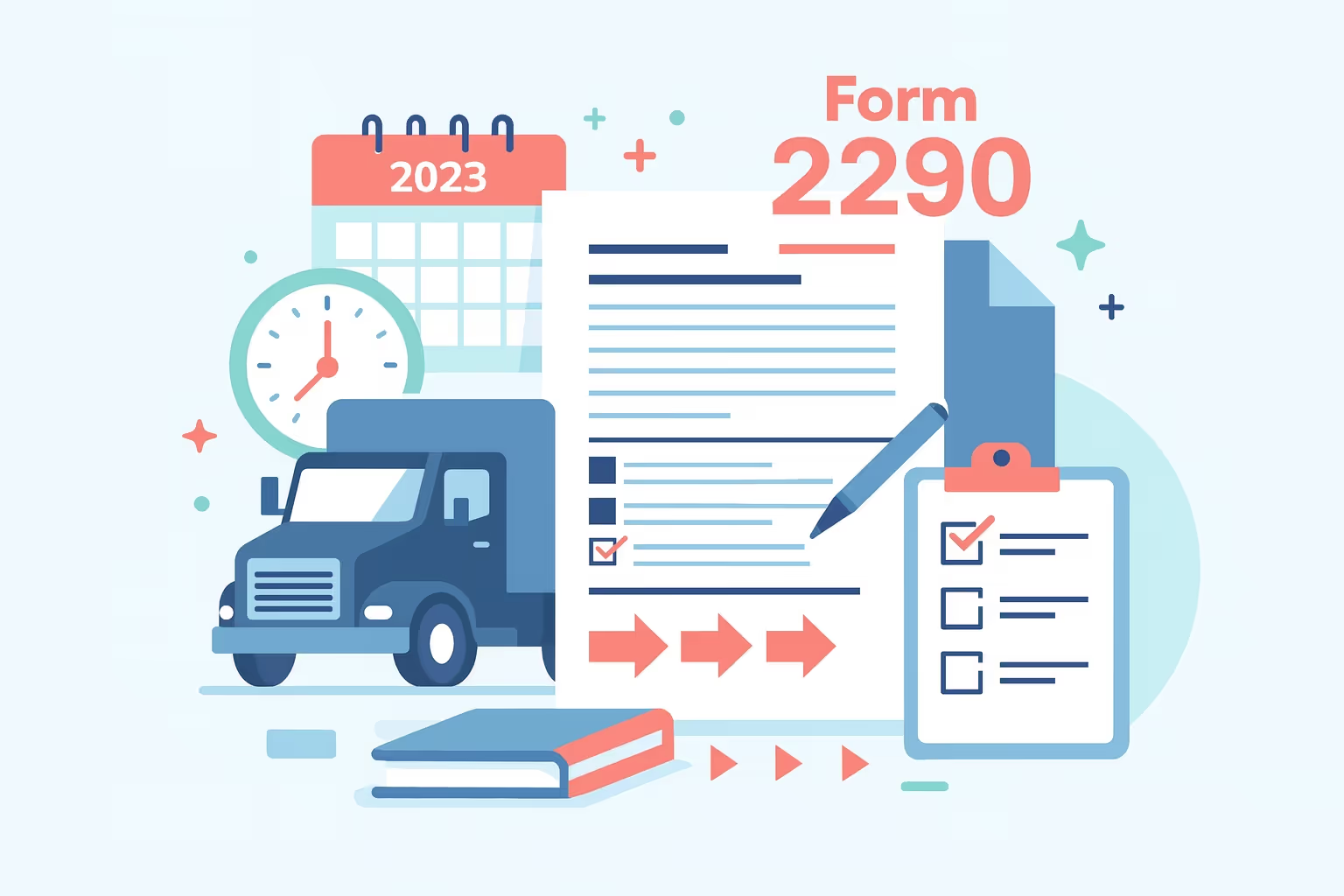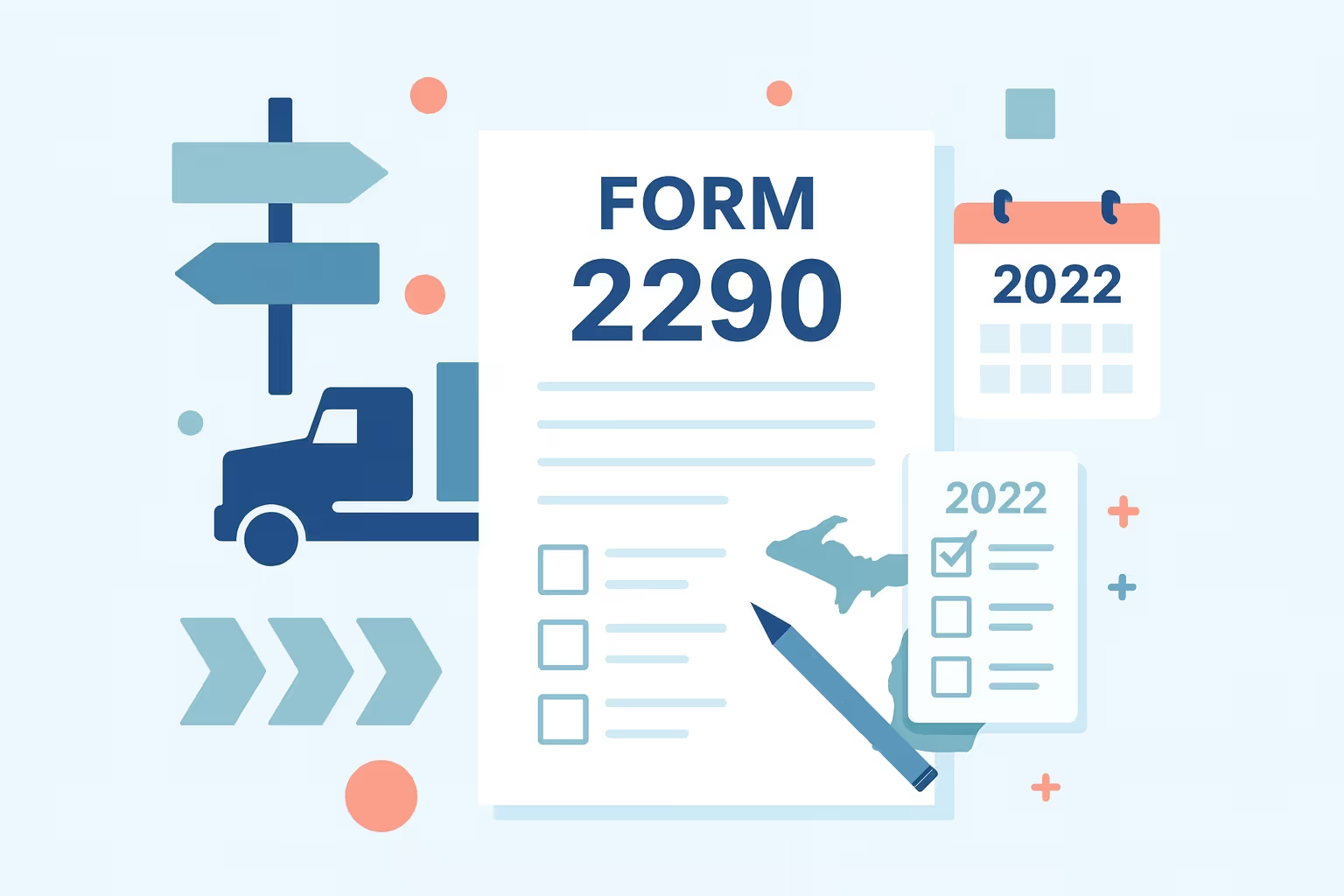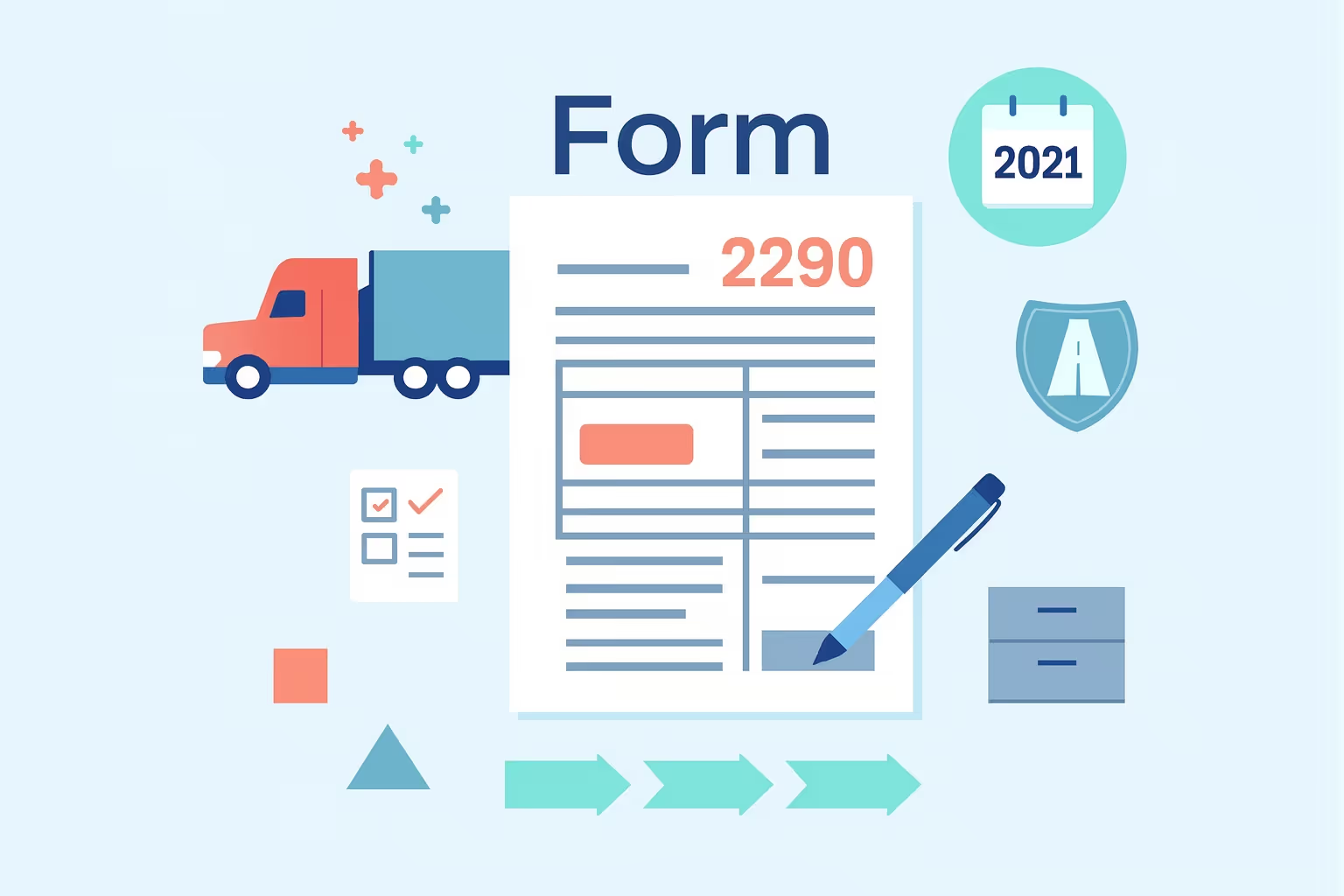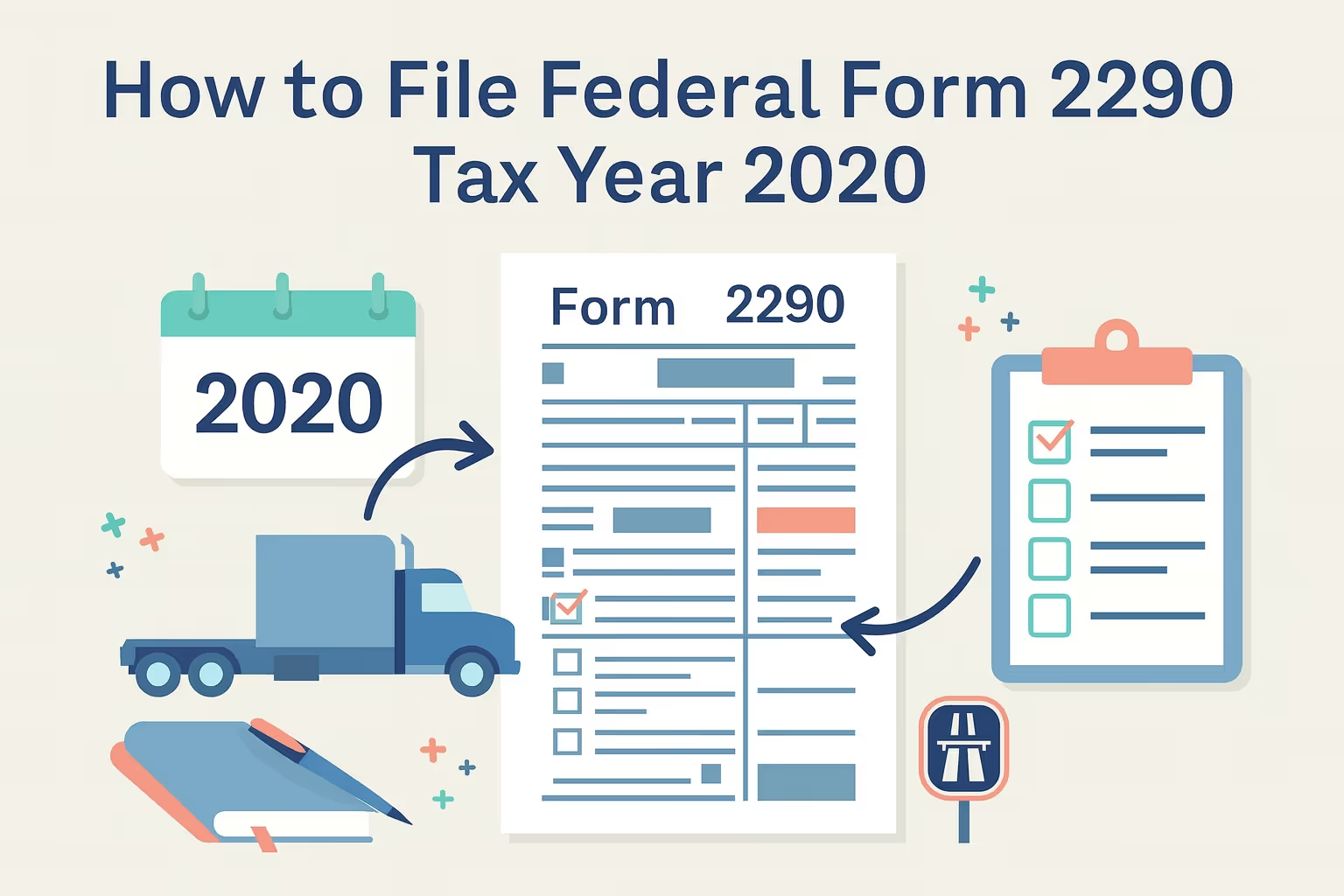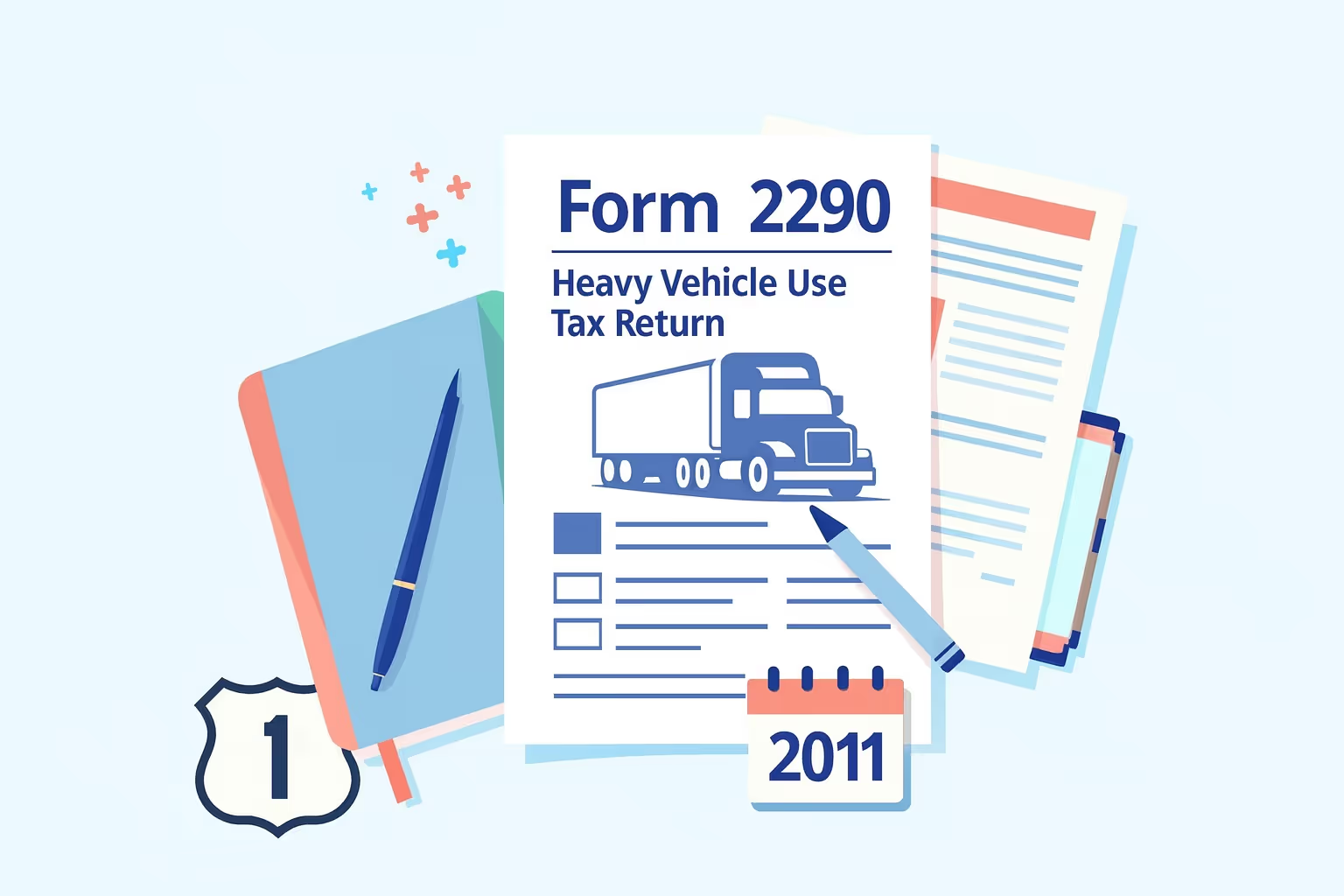Form 2290 Tax Year 2019: Heavy Vehicle Use Tax Guide

Form 2290 tax year 2019 is an essential filing requirement for owners and operators of heavy motor vehicles that operate on public highways. This form covers the Heavy Vehicle Use Tax (HVUT), which applies to trucks weighing 55,000 pounds or more. The filing season for 2019 began on January 1, 2019, and ran through April 15, 2020. Anyone subject to this tax must submit the required return, pay the fee, and obtain proof of payment before they can renew vehicle registration with the DMV.
To complete the process, filers need an Employer Identification Number, a vehicle identification number for each truck, and the taxable gross weight of their motor vehicles. This information is used to calculate the amount of tax owed using the IRS tax table. Once the return is signed, dated, and submitted, the IRS returns Schedule 1 with an official stamp that confirms tax payment. Without this proof, individuals may not be able to operate their vehicles legally, which can impact both personal and business operations, as well as compliance with federal law.
The purpose of this guide is to simplify complex tax requirements for drivers and companies who need to file during this specific season. Each section will provide clear instructions, from learning how to electronically file to understanding HVUT payment methods. Readers will also learn how to request assistance, handle exemptions, and ensure that the return is accurate and complete. By the end, you will feel confident about entering your details, mailing or submitting your return online, and receiving the necessary documents to continue operating your vehicle without worry.
What Is HVUT Tax and Who Must Pay It?
Understanding HVUT is the first step in filing Form 2290 for the 2019 tax year. Many truck owners and companies feel overwhelmed when they hear about the Heavy Vehicle Use Tax. Breaking it down into clear sections helps explain who is subject to the fee, which vehicles qualify for exemptions, and how taxable gross weight is determined. This foundation makes it easier to complete the tax return correctly during the filing season.
Heavy Vehicle Use Tax (HVUT) Defined
The Heavy Vehicle Use Tax (HVUT) applies to trucks, truck tractors, and buses with a taxable gross weight of 55,000 pounds or more. These motor vehicles travel on public highways, and the tax supports highway maintenance and repairs. Each vehicle subject to this requirement must be reported on Form 2290 during the active filing period. Paying HVUT confirms compliance with federal law and allows vehicles to remain in operation.
Who Must File and Pay
Owners and operators of taxable vehicles must submit a tax return once a truck is placed in service. The rule applies to individuals, companies, and nonprofit organizations. Filing and paying the required fee results in a stamped Schedule 1, which serves as proof of tax payment. This document is necessary for DMV registration renewal and ensures the uninterrupted operation of the vehicle.
Vehicles Exempt from HVUT
Some vehicles may qualify for exemption. Agricultural trucks that travel fewer than 7,500 miles in a year can claim suspension. Non-agricultural trucks may be eligible if they operate fewer than 5,000 miles in the filing season. Government-owned vehicles and those operated by recognized nonprofit organizations are also exempt from this requirement. Even in these cases, owners must still file Form 2290 and enter each vehicle identification number to document exempt status.
How Taxable Gross Weight Is Calculated
The HVUT amount depends on a vehicle’s taxable gross weight. This calculation includes the unloaded weight of the truck, the unloaded weight of the trailers typically used, and the maximum load that can be carried. The result determines the vehicle’s category on the IRS tax table. Providing accurate details, such as the VIN, weight, and date of first highway use, helps prevent delays in receiving Schedule 1.
Compliance Benefits
Meeting HVUT obligations helps truck owners prevent registration problems and maintain access to public highways. By filing correctly and paying on time, operators maintain legal standing, reduce processing delays, and keep their businesses running smoothly throughout the filing season.
IRS Form 2290 Instructions and Filing Season Rules
Form 2290 tax year 2019 follows a set filing calendar that applies to all taxable heavy vehicles operating on public highways. The 2019 tax year ran from July 1, 2019, through June 30, 2020. Any vehicle weighing 55,000 pounds or more that was first used in this period required a correctly submitted tax return. Meeting these requirements ensures that owners receive proof of tax paid, which is necessary for DMV registration and continued operation.
Filing Season Requirements
To complete Form 2290 accurately, filers must provide business and vehicle information. This includes identification numbers, taxable gross weight, and the month of first highway use. These details confirm the filing deadline, the amount owed, and the record of payment that allows vehicles to remain in service.
Information You Must Include
- Employer Identification Number (EIN): This number is required for all filers, and Social Security Numbers are not accepted.
- Vehicle Identification Number (VIN): Each VIN must be entered correctly for every taxable vehicle.
- Taxable Gross Weight: This figure is used to determine the Heavy Vehicle Use Tax payment from the IRS tax table.
- Month of First Use: This date establishes the specific deadline for filing the return.
- Business and Contact Information: Filers must include the mailing address, phone number, and the name of the person authorized to sign on behalf of the entity.
- Schedule 1: Filers must complete both copies; one will be returned stamped as confirmation of tax paid.
Filing Deadlines for 2019
The deadline for Form 2290 depends on when the vehicle is first used during the tax year. For example, trucks placed into service in July 2019 had to be filed by September 3, 2019, since the August deadline fell on a weekend. Vehicles first used in August were required to be filed by September 30, 2019, and those first used in September were due by October 31, 2019. Generally, returns are due on the last day of the month following the first month of use.
Filing Methods
Form 2290 may be mailed or submitted electronically. Anyone reporting 25 or more taxable vehicles must file online, but smaller operators also benefit from electronic filing. Many choose to file Form 2290 electronically because the process minimizes data-entry errors and provides Schedule 1 more quickly. Mailing the form remains an option for those with fewer vehicles, though payments must be enclosed or sent with Form 2290-V.
Completing the form correctly and on time prevents processing delays that may interrupt DMV registration. Understanding the filing season rules builds confidence, allowing operators to remain compliant while keeping vehicles registered without disruption.
Step-by-Step Guide to Completing Form 2290
Completing Form 2290 tax year 2019 requires accuracy and attention to detail. Each field on the return plays a role in determining the Heavy Vehicle Use Tax owed, confirming vehicle eligibility, and providing proof of payment for registration. Following the correct sequence ensures the return is accepted promptly and the stamped Schedule 1 is received without delay.
Step 1: Enter Business and Identification Information
Begin by entering your legal business name, complete address, and Employer Identification Number. The IRS does not accept Social Security Numbers for this filing, so obtaining an EIN in advance is essential. Ensure the name on the return matches the name in IRS records, as mismatched entries may result in rejection. Include a reliable phone number to allow contact if further clarification is required.
Step 2: Provide Vehicle Details
Each taxable vehicle must be listed with its vehicle identification number, taxable gross weight, and the month of first highway use. Trucks, truck tractors, and buses subject to HVUT must be reported individually. Entering the correct VIN ensures proper identification for future renewals with the DMV. Errors in this section often delay processing, so accuracy is critical.
Step 3: Calculate the Tax Owed
Use the IRS tax table included with Form 2290 to determine the Heavy Vehicle Use Tax payment. The calculation depends on the vehicle’s weight category and whether it qualifies as a logging vehicle. Lighter vehicles within the taxable range owe less, while the heaviest trucks owe up to the maximum fee. Ensure the figures are accurate to avoid discrepancies that could impact the stamped Schedule 1.
Step 4: Complete Schedule 1
Schedule 1 serves as proof of tax paid and is necessary for registration renewal at the DMV. List all taxable vehicles by VIN, ensuring the information is consistent with the information on the main form. Complete both copies of Schedule 1, as one will be stamped and returned after processing. Keep this stamped copy with your records to present when registering or renewing your vehicle.
Step 5: Choose Filing Method and Sign
After completing the form, decide whether to file or submit a paper return electronically. Those reporting 25 or more vehicles must electronically file, while smaller operators may choose either method. If mailing the form, include Form 2290-V when paying by check or money order. The filer must sign and date the return before submission, as unsigned forms are considered incomplete.
Step 6: Submit and Track the Return
Please submit the completed form using your chosen method and retain a copy for your records. Electronic filing provides quicker confirmation and faster receipt of Schedule 1, often within minutes. Paper returns may take several weeks to process; therefore, planning is crucial. Once the stamped Schedule 1 is received, use it to renew registration or confirm compliance when operating across state or national borders.
Completing Form 2290 through these steps helps vehicle owners remain compliant during the filing season. Providing correct business information, vehicle details, and tax calculations prevents delays and strengthens record reliability. With careful preparation, truck owners and companies can continue operating on public highways while meeting all Heavy Vehicle Use Tax obligations.
How to Electronically File with an E File Provider
Electronic filing is the preferred method for submitting Form 2290 for the 2019 tax year, especially for businesses operating multiple vehicles. The IRS requires electronic filing when an owner reports 25 or more taxable vehicles, although operators with fewer vehicles are encouraged to use the same process. Choosing an approved provider reduces errors, speeds up processing, and provides faster access to the stamped Schedule 1, which serves as proof of tax paid.
Steps to Electronically File
- Choose an IRS-Approved E File Provider
Select a provider authorized to process Form 2290 electronically. These providers connect directly with IRS systems and deliver official confirmation of filing. Review each provider’s services, fees, and support options to choose the one that best fits your filing needs. - Obtain or Confirm Employer Identification Number
An Employer Identification Number must be active before electronic filing. If applying for one, allow several weeks for the IRS to activate the record in its systems. The EIN ensures that the tax return is filed against the correct account. - Prepare Required Information
Gather business details, including the legal name, complete address, and a reliable contact phone number. Collect each vehicle’s identification number, taxable gross weight, and the month of its first highway use. Accurate preparation prevents processing delays and ensures the correct calculation of the Heavy Vehicle Use Tax payment. - Enter Data into the Provider’s System
Upload or enter all business and vehicle information directly into the electronic system. Many providers include checks that alert filers to missing or incorrect entries. This step helps maintain accuracy and reduces the chance of rejected returns. - Select Payment Method
Choose how to submit the Heavy Vehicle Use Tax payment. Options include Electronic Federal Tax Payment System (EFTPS), electronic funds withdrawal, or mailing a check with a completed voucher. Confirm the payment method before submitting the return. - Submit and Receive Stamped Schedule 1
Once the return is submitted, the IRS processes the information and returns a stamped Schedule 1. Electronic filing often produces this proof of tax paid within minutes. Save both electronic and printed copies for DMV registration and future recordkeeping.
Electronic filing with an approved provider offers faster processing and greater convenience compared to mailing paper returns. The system helps ensure accurate entry of critical data such as VINs, dates, and taxable weight. By following these steps, truck owners and operators secure the documentation required to operate vehicles legally while maintaining compliance with the Heavy Vehicle Use Tax filing season.
Payment Options for HVUT
Meeting the Heavy Vehicle Use Tax payment requirement finalizes the Form 2290 tax year 2019 filing process. Owners and operators must select a method that aligns with their filing approach, ensuring accuracy and compliance with relevant regulations. Each option requires the correct entry of the Employer Identification Number, payment amount, and vehicle identification number to confirm that the tax paid is appropriately recorded.
Electronic Federal Tax Payment System (EFTPS)
The Electronic Federal Tax Payment System (EFTPS) is a secure online service provided by the U.S. Department of the Treasury. Taxpayers can make payments online or by phone after enrolling in the system. Activation may take several weeks, so planning is essential. Once active, EFTPS allows users to schedule payments, receive confirmation, and keep detailed records.
Electronic Funds Withdrawal (EFW)
This option is available only when electronically filing Form 2290. The payment is withdrawn directly from the designated bank account on the chosen filing date. Filers should confirm that their accounts have sufficient funds so the payment process can proceed without delays.
Check or Money Order
Paper filers may pay with a check or money order made payable to the United States Treasury. The payment must include Form 2290-V, which links the amount to the correct account. Filers should write the Employer Identification Number, vehicle identification number, and tax year on the memo line to ensure accurate posting.
Restrictions for Credit and Debit Cards
During the 2019 filing season, the IRS suspended credit and debit card payments for Form 2290, requiring truck owners to rely on EFTPS, EFW, or mailed payments. Selecting one of these available methods and submitting the payment on time ensured the timely issuance of Schedule 1. Choosing the right payment option supported compliance, reduced delays, and ensured that heavy vehicles remained eligible for legal operation on public highways.
Suspended Vehicles and Exempt Mileage
Not all heavy vehicles are subject to paying the Heavy Vehicle Use Tax. Specific trucks and buses may qualify for suspension or exemption if they meet particular mileage and usage requirements. Filing remains necessary, but these vehicles are reported differently to reflect their reduced or exempt tax status.
Conditions for Vehicle Suspension
- Mileage Limit for Non-Agricultural Vehicles: Mileage Limit for Non-Agricultural Vehicles: A vehicle that is used 5,000 miles or fewer during the filing season qualifies for suspension.
- Mileage Limit for Agricultural Vehicles: An agricultural truck qualifies for suspension if it is used for 7,500 miles or fewer in the same period.
- Category W Reporting: Each suspended vehicle must be entered under category W on Schedule 1.
- Filing Requirement: Owners must submit a return to document the suspension of their tax liability, even when no tax is owed.
Exempt Vehicles
- Government-Owned Vehicles: These vehicles include trucks operated by federal, state, or local governments.
- Nonprofit Organizations: These vehicles include those owned by recognized charitable or educational entities.
- Qualified Exempt Use: A vehicle that is used strictly for approved exempt purposes must still be reported on Form 2290.
Exceeding Mileage Limits
- Amended Return Required: An amended Form 2290 must be filed if a suspended vehicle exceeds mileage limits.
- Additional Tax Payment: The additional HVUT payment must correspond to the date the vehicle exceeded the threshold for the applicable tax year.
- Deadline: An amended return must be filed by the last day of the month following the month in which the excess mileage occurred.
Recordkeeping for Suspended Vehicles
- Mileage Logs: Filers must maintain accurate odometer readings or trip reports.
- Proof of Transfer: A signed statement must be provided if a vehicle is sold during the tax year that was previously suspended.
- Supporting Documents: All records must be kept for inspection in case the IRS requests verification.
Suspended and exempt vehicles apply to operators with limited highway use, and they must still be reported to remain compliant. Reporting these vehicles correctly ensures accurate records and avoids complications during registration or future transfers.
Common Mistakes and Compliance Issues
Errors in completing Form 2290 can cause delays in receiving proof of tax paid and create complications during vehicle registration. Many issues result from inaccurate entries or overlooked filing rules, both of which can affect compliance. Understanding the most common mistakes helps truck owners and companies avoid unnecessary problems during the filing season.
Frequent Filing Errors
- Incorrect Employer Identification Number: A filer who uses a Social Security Number or enters an incorrect EIN will have the return rejected.
- Wrong Vehicle Identification Number: A mistyped VIN prevents the vehicle from accurately linking to the return.
- Improper Weight Category: When a filer reports the wrong taxable gross weight, the result is an incorrect HVUT payment amount.
- Missed Deadlines: If a return is filed after the due date, it can lead to increased processing delays and potentially trigger compliance issues.
- Unsigned Returns: A form submitted without a proper signature is considered incomplete.
- Incomplete Schedule 1: A form submitted without a proper signature is considered incomplete.
Compliance Challenges
Truck owners must ensure that all required documents, including Schedule 1, are kept on file and submitted to the DMV when renewing their registration. Payments that do not match the declared filing date or vehicle details may trigger an IRS review, resulting in processing delays. Recordkeeping also plays an important role, as mileage logs and proof of payment may be reviewed in the event of an audit.
Careful attention to details, such as vehicle weight and correct VINs, as well as timely submission, reduces the risk of rejected returns. Filing accurately not only secures the stamped Schedule 1 but also strengthens a company’s compliance record. When errors are avoided, the filing process becomes more efficient, and vehicle operators can focus on running their transportation services without unnecessary interruptions.
First-Time Filers: How to Obtain an EIN and Prepare
First-time filers must complete additional steps before submitting Form 2290. The process begins with securing an Employer Identification Number, which the IRS requires for all tax filings. Preparing in advance with accurate records and identification details ensures a smoother experience during the filing season.
Employer Identification Number (EIN)
An Employer Identification Number is a unique nine-digit code that identifies a business or individual as a tax filer. The IRS issues EINs for use on tax returns, and Social Security Numbers cannot replace them when filing Form 2290. Applicants can request an EIN online through the IRS EIN application page, by fax, or by mail. Because new EINs can take several weeks to be activated in IRS systems, filers should apply early to avoid delays.
Preparing Before Filing
First-time filers must gather essential details about their vehicles and business operations. Required information includes the legal business name, address, and reliable contact phone number. Vehicle records must consist of the vehicle identification number, taxable gross weight, and the month of first highway use. Collecting this data early prevents mistakes during the submission process.
Why Preparation Matters
Without an EIN or proper documentation, a Form 2290 submission cannot be processed. First-time filers who attempt to submit using incomplete records often face delays in receiving their stamped Schedule 1. Proper preparation ensures that HVUT payments are calculated correctly and the vehicle remains eligible for registration at the DMV.
Obtaining an EIN and preparing all necessary records form the foundation for filing Form 2290 successfully. First-time filers who complete these steps carefully position themselves for timely processing, accurate HVUT payment, and uninterrupted operation of their vehicles on public highways.
Frequently Asked Questions
Who is required to file Form 2290?
Any owner of heavy motor vehicles that operate on public highways and weigh 55,000 pounds or more must file Form 2290. This requirement applies to individuals, companies, and nonprofit organizations. The tax return ensures proper HVUT payment and provides the necessary proof for DMV vehicle registration. Filing accurately with the correct vehicle identification number ensures consistent records, avoids delays, and confirms that the tax paid supports federal highway programs.
When is the Form 2290 filing season?
The filing season for Form 2290 begins on July 1 and ends on June 30 of the following year. Each filer must submit the return and pay the required fee by the last day of the month following the first date of highway use. Filing promptly helps operators renew registration, receive Schedule 1 without delays, and continue to operate vehicles legally across the country.
What information is required to complete Form 2290?
Filers must gather several key details before submitting the form. Required information includes Employer Identification Number, business name, address, and contact phone number. Vehicle information, such as taxable gross weight, month of first use, and vehicle identification number, must also be entered. Collecting this data in advance ensures accurate calculation of HVUT payment and prevents rejected tax returns during the filing process.
How can I electronically file Form 2290?
Filers may electronically file through an IRS-approved file provider. The system requires the entry of business information, vehicle identification numbers, taxable gross weight, and the date of first use. Once the tax return is submitted and the HVUT payment is confirmed, Schedule 1 is returned electronically. This document verifies the tax paid and enables quick renewal of DMV registration, avoiding the long processing times associated with mailing paper forms.
Are there vehicles exempt from HVUT tax?
Yes, certain vehicles qualify for exemption or suspended status under HVUT tax rules. Agricultural cars with fewer than 7,500 miles and non-agricultural trucks with fewer than 5,000 miles may qualify. Government-owned vehicles and those operated by nonprofit organizations may also be exempt from this requirement. Even exempt vehicles must appear on the tax return and include accurate vehicle identification numbers, ensuring compliance with filing rules and maintaining records for DMV registration.
How do I make my HVUT payment?
Payment options include Electronic Federal Tax Payment System (EFTPS), electronic funds withdrawal when e-filing, or mailing a check or money order. During the 2019 filing season, credit and debit card payments were suspended. Each payment must include the Employer Identification Number, tax year, and vehicle identification number. Selecting the correct option ensures the timely posting of the HVUT payment and guarantees that the stamped Schedule 1 is issued without delay.
Why is Schedule 1 crucial for truck owners?
Schedule 1 provides proof that HVUT tax has been paid and is recorded with the IRS. This stamped document is required to renew vehicle registration and confirm eligibility for operation on public highways. Truck owners also need Schedule 1 when crossing borders or transferring ownership of a vehicle to another person. Receiving this form promptly through electronic filing helps operators avoid registration delays and ensures continued compliance with federal requirements during the filing season.
















